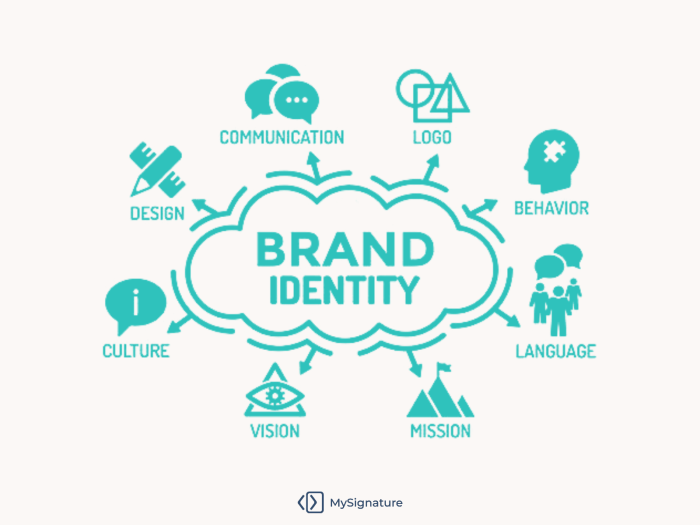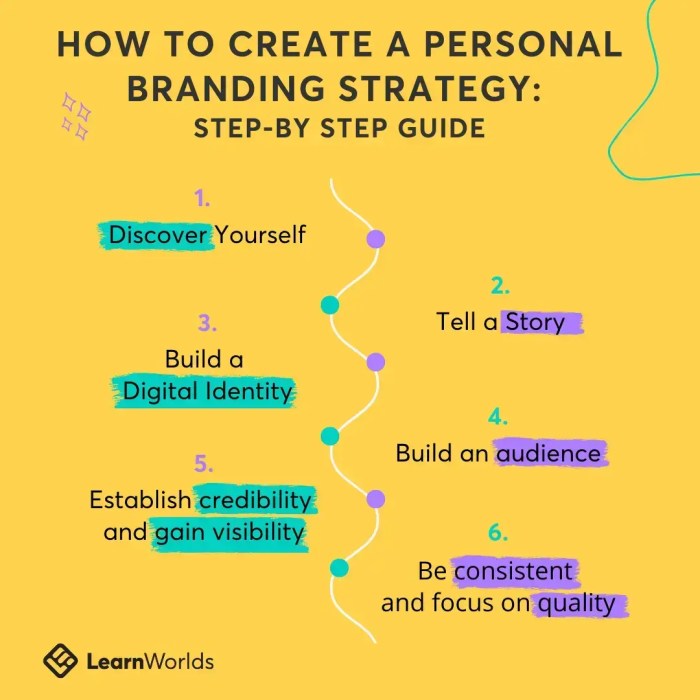Creating a Personal Branding Strategy dives into the essence of crafting a distinct identity that sets you apart in a crowded digital world. From defining your brand to engaging your audience, this journey is all about making your mark and leaving a lasting impression.
As you navigate through the intricacies of personal branding, you’ll uncover the secrets to building an online presence that resonates with your target audience and speaks to your core values. Get ready to unlock the power of your personal brand and watch your influence soar.
Understanding Personal Branding Strategy
Personal branding is all about how you present yourself to the world, both online and offline. It involves creating a unique identity that showcases your skills, values, and personality. Your personal brand is what sets you apart from others and influences how people perceive you.Having a personal branding strategy is crucial in today’s competitive job market. It helps you stand out from the crowd, attract opportunities, and build credibility in your field.
A well-defined personal branding strategy can open doors for career advancement, networking, and personal growth.
Key Components of a Successful Personal Branding Strategy
- Define Your Brand Identity: Identify your unique strengths, values, and passions that set you apart from others.
- Create a Consistent Online Presence: Develop a strong online presence through social media, personal website, and professional profiles that reflect your brand identity.
- Showcase Your Expertise: Share your knowledge and expertise through blogs, articles, speaking engagements, and other platforms to establish yourself as an authority in your field.
- Engage with Your Audience: Build relationships with your audience by interacting, responding to comments, and sharing valuable content that resonates with them.
- Seek Feedback and Adapt: Be open to feedback, learn from your experiences, and constantly refine your personal brand to stay relevant and authentic.
Defining Your Brand Identity
When it comes to defining your brand identity, it’s all about figuring out what makes you stand out from the crowd. Your unique brand identity is what sets you apart from everyone else and helps you connect with your audience on a deeper level.
Identifying Your Unique Value Proposition
Your unique value proposition is what makes you different from your competitors and why customers should choose you over them. It could be your expertise in a particular area, your innovative approach to solving problems, or your exceptional customer service.
- Take some time to reflect on what makes you special and write down your unique value proposition.
- Look at successful brands in your industry and see how they differentiate themselves.
- Ask for feedback from friends, family, and colleagues to gain different perspectives on your strengths.
Aligning Your Brand Identity with Your Values and Goals
Your brand identity should reflect your values and goals as a person or a business. It’s important to ensure that your brand messaging, visuals, and actions are all aligned with what you stand for.
Successful brand identities, like Nike and Apple, have a strong alignment between their brand identity and values, which resonates with their target audience.
- Define your core values and make sure they are reflected in your brand messaging.
- Set clear goals for your brand and ensure that all your actions are working towards achieving them.
- Consistently communicate your brand identity across all platforms to build brand recognition and loyalty.
Target Audience and Market Research

Defining your target audience and conducting market research are crucial steps in creating a successful personal brand. By understanding who your audience is and what they need, you can tailor your brand to meet those specific needs and stand out in the market.
Significance of Defining Your Target Audience
Identifying your target audience allows you to focus your efforts on the people who are most likely to engage with your brand. This helps you create content, products, and services that resonate with your audience, leading to stronger connections and loyalty.
- Define demographics: Understand the age, gender, location, income level, and other relevant characteristics of your target audience.
- Identify psychographics: Determine the values, beliefs, interests, and behaviors of your audience to tailor your brand messaging effectively.
- Segment your audience: Divide your audience into different segments based on their needs and preferences to create targeted marketing strategies.
Importance of Conducting Market Research
Market research helps you gather valuable insights about your industry, competitors, and target audience. It enables you to make informed decisions about your brand positioning, messaging, and offerings to stay competitive and relevant in the market.
- Analyze competitors: Study your competitors to identify gaps in the market, understand their strategies, and differentiate your brand effectively.
- Identify trends: Stay updated on industry trends, consumer preferences, and market dynamics to adapt your brand strategy accordingly.
- Collect feedback: Gather feedback from your audience through surveys, interviews, and social media interactions to improve your brand and customer experience.
Strategies for Identifying and Understanding Your Target Audience
To effectively identify and understand your target audience, consider implementing the following strategies:
- Conduct surveys and interviews: Engage directly with your audience to gather feedback, preferences, and pain points to tailor your brand accordingly.
- Utilize analytics tools: Use analytics tools to track website traffic, social media engagement, and customer behavior to gain insights into your audience’s interests and preferences.
- Monitor social media: Analyze social media interactions, comments, and shares to understand how your audience perceives your brand and what resonates with them.
Developing Your Online Presence
In today’s digital age, having a strong online presence is crucial for building your personal brand. Social media plays a significant role in shaping how you are perceived by your audience, making it essential to carefully curate your online identity.
The Role of Social Media in Personal Branding
Social media platforms serve as powerful tools for showcasing your skills, expertise, and personality to a wide audience. By consistently sharing valuable content and engaging with your followers, you can establish yourself as an authority in your field and build a loyal community around your brand.
Tips for Creating a Cohesive Online Presence
- Ensure consistency across all platforms in terms of profile picture, bio, and content style to reinforce your brand identity.
- Share content that aligns with your brand values and resonates with your target audience to maintain authenticity.
- Engage with your followers by responding to comments, messages, and mentions to foster a sense of community and connection.
- Utilize visual elements such as color schemes, fonts, and graphics that reflect your brand’s personality and appeal to your audience.
Platforms Best Suited for Your Personal Brand
Choosing the right social media platforms is crucial for effectively reaching and engaging with your target audience. Consider the following platforms based on your brand identity and audience demographics:
| Platform | Best For |
|---|---|
| Visual content and a younger audience | |
| Professional networking and industry connections | |
| YouTube | Video content and tutorials |
| Real-time updates and quick engagement |
Content Creation and Marketing

Creating valuable content for your brand is crucial in establishing your identity and connecting with your audience. High-quality content helps to showcase your expertise, build credibility, and engage your followers. It sets you apart from competitors and positions you as a thought leader in your industry.
Strategies for Content Creation and Marketing
- Identify your target audience and their preferences to tailor your content accordingly.
- Create a content calendar to plan and organize your posts, ensuring consistency and relevancy.
- Diversify your content formats, such as blog posts, videos, infographics, and podcasts, to cater to different audience preferences.
- Collaborate with influencers or other brands to expand your reach and attract new followers.
- Utilize techniques to optimize your content for search engines and increase visibility.
Engaging Your Audience through Content, Creating a Personal Branding Strategy
- Encourage interaction by asking questions, hosting polls, or running contests to involve your audience.
- Respond to comments and messages promptly to show that you value your followers’ input and engagement.
- Share user-generated content to showcase your community and build a sense of belonging among your followers.
- Create compelling storytelling content that resonates with your audience on an emotional level.
- Monitor analytics and feedback to understand what type of content performs best and adjust your strategy accordingly.
Networking and Building Relationships: Creating A Personal Branding Strategy
Networking is a crucial component of personal branding, as it allows individuals to expand their reach, build connections, and establish credibility within their industry. Building meaningful relationships within your industry can open doors to new opportunities, collaborations, and professional growth. Successful networking strategies involve genuine interactions, consistent communication, and a focus on adding value to others.
Engage with Industry Events and Communities
- Attend industry conferences, seminars, and networking events to meet like-minded professionals and potential collaborators.
- Join online forums, social media groups, and professional associations to engage in discussions, share insights, and build relationships.
- Offer to speak at events or contribute content to establish yourself as a thought leader in your field.
Utilize Social Media Platforms
- Connect with industry influencers, peers, and potential clients on platforms like LinkedIn, Twitter, and Instagram.
- Share valuable content, engage with others’ posts, and participate in relevant conversations to showcase your expertise and personality.
- Use social media to reach a wider audience, promote your brand, and stay updated on industry trends.
Follow Up and Nurture Relationships
- Send personalized follow-up messages after networking events to express gratitude and continue the conversation.
- Stay in touch with your contacts through regular check-ins, sharing relevant updates, and offering support when needed.
- Focus on building long-term, mutually beneficial relationships by providing value, being authentic, and showing genuine interest in others.
